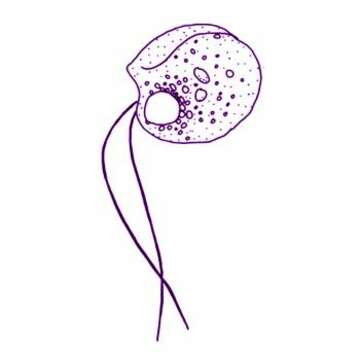Drawing

Description :
Heteramoeba clara Droop, 1962. The flagellate stage can form a more or less spherical cell up to 30 microns in diameter. There are two equal nearly equal flagella, 60 microns long, held, as far as one can see, tangentially when the organism is moving, they cause the cell to rotate about the axis of forward motion with a period varying from about a second in the larger, to a quarter of a second in the smaller individuals. There is deep cytostome, a furrow lying between the main body and a curved enfolding collar: In the globular mature cell the collar forms an incomplete circle around what appears to be the anterior pole, with the flagellar insertion at the outer edge of one end of it, but it is clear from smaller pyriform cells that the true orientation of collar and cytostome is lateral. The cytoplasm is clear in the absence of ingested food: there are no contractile vacuoles and no stigma or chloroplasts, but the large spherical, empty nucleus is conspicuous in the anterior part of the cell. It lies very close to the flagellar insertion and is surrounded mostly towards the rear, by a layer of small highly refractive inclusions. The cell membrane is firm, but can easily be deformed when food taken in, the cytostomal collar especially is so elastic as to enable the flagellate to surround and engulf prey twice its riormal size.
Inclus dans les pages suivantes :
- Life
- Cellular (Organismes cellulaires)
- Eukaryota (eucaryotes)
- Excavates
- Discoba
- Heterolobosea
- Tetramitia
- Eutetramitia
- Vahlkampfiidae
- Heteramoeba
- Heteramoeba clara
Cette image ne figure dans aucune collection.
Informations sur la provenance
- licence
- cc-by-nc
- auteur
- Won Je Lee
- fournisseur
- micro*scope
- original
- fichier de média d’origine
- visiter la source
- site partenaire
- micro*scope
- ID


